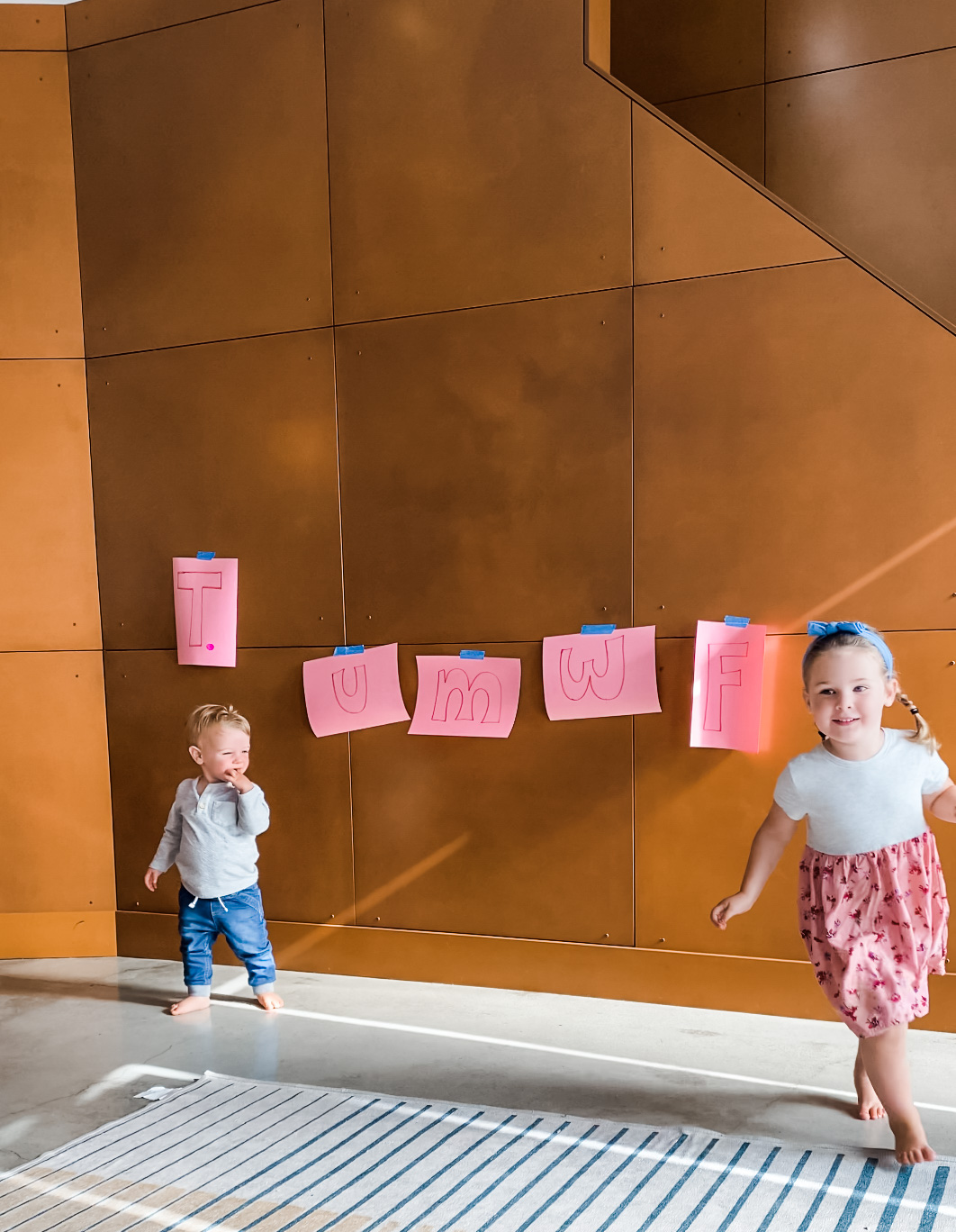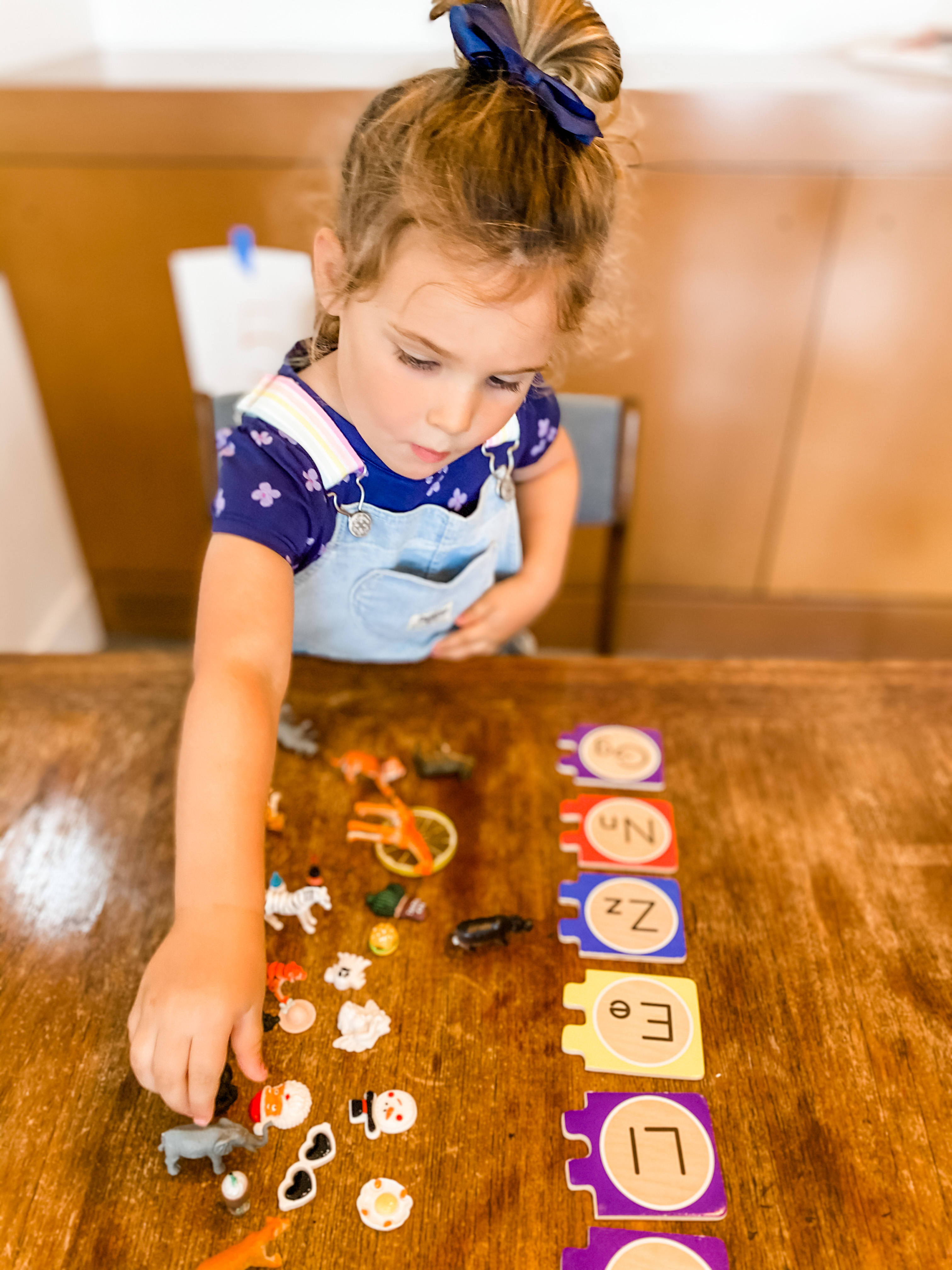I want to preface this by emphasizing the fact that I am not a home-school mom, or even a preschool teacher. I also desperately miss my daughter’s in-person preschool, and the bazillion things they were able to teach, that I can not. One of the reasons that I love preschool, or playgroups, or group-home-school (or whatever you call it) is my firm belief in the fact that kids need to learn from other kids. When she was at school, or around her friends on play-dates or at birthday parties, pre-Covid Margot was learning how to express and regulate her emotions, make and outgrow friendships, solve problems, advocate for herself, move her body, deal with conflict, etc. In fact, I think that in preschool and kindergarten especially, academics are probably the lowest on the list of skills kids really need to develop.
However, a lot of these social, emotional and physical skills are developed organically, through taking my kids to the nature park, or hanging out with friends, or by me sitting back and watching while my kids duke it out over an empty Amazon box. The teaching of “soft” skills is not really something I plan for, so it’s difficult to write about. It is also something that has become harder and harder to do, as we keep getting pushed back into isolation.
Reading, however, is a skill that can and should be taught. And it is one of the few skills that I think is best taught one-on-one. So, I am here today to share with you all a little bit about how I have been practicing some early phonics skills with my daughter while she is out of school, and away from most of the other kiddos she normally learns from and with.
For reference, my daughter is almost 3.5 years old. She is also a girl. (Controversial topic alert!) In my experience (and this is also backed by research), girls develop more quickly than boys, and take to traditional “school” settings more naturally. What I am doing with Margot at 3.5 may be very different than what I do with my son at 3.5, or with a different, future daughter at the same age. So take it all with a grain of salt, and never ever feel bad if your kid “can’t” do something yet. They’ll all just end up on TikTok eventually anyway.
Letter Sound Hide and Find:

This first activity is a fan favorite in our house, and it’s pretty straight forward. A few weeks ago, I made a “set” of letters, which are just 26 pieces of computer paper, with one upper-case letter written on each one. If you want to get all fancy, you can laminate them, which I may do the next time I visit my classroom.
To set up, Margot and I wander around our living room and find good “hiding spots” for each letter (don’t pick anything too hard–you want your kids to be able to see them). We tape each paper to it’s hiding place using painter’s tape, and then return to the center of the room.
The first few times we played this game, I would ask Margot to find the letter (aka: “where’s the A?”), and she would run to it’s hiding place and either yell, or ring her “teacher bell” when she found it.
When she became pretty proficient in recognizing most of the letters, we moved on to letter sounds. I would ask Margot to find me the letter that makes the “ooo” sound, and she would have to find the letter O. Recently, I have added a few letter pairs to the wall, so she can find the “sh” or “ch” sound as well as single letter sounds.
Margot loves this game because she gets to run around a room that we normally don’t “run” in. Sometimes I mix it up by making her close her eyes while I move letters to new hiding places. Sometimes her brother participates, and chases after her, or pulls letters off the wall before she can get there, which is annoying, but adds a layer of excitement for everyone involved.
Remember, this game, like all of the ones included in this post, should be fun. I recommend playing when your child shows interest, and stopping when they start getting bored. The more you can make this an “exciting” activity, the more they will learn from it.
Letter Sound & Object Matching:

This game is probably my favorite, as it involves cute toys, and allows me to sit down.
To play this game, you first need a collection of objects. You should have one object that matches each letter of the alphabet. I use this set of objects from Amazon, but had to add a few of our own toys to hit all the letters. (We also drew a slightly terrifying skeleton (aka X-Ray) on the outside of one of our plastic dinosaurs to serve as an example for the letter X. Because literally nothing starts with X.)
The goal of this activity is for the child to match each object to the letter it starts with. When we play, I will ask Margot, “which object starts with the “ssss” sound?” to which she will reply “STARBUCKS!” (Yes, that is one of the objects in this set).
We have this Melissa and Doug Alphabet Puzzle, so I usually lay out all the pieces ahead of time, and ask Margot to place each object on the correct letter after she identifies the starting sound. We have played this game outside as well, and placed the objects on letters we drew on the sidewalk with chalk.
You can switch it up by asking kids to think about colors or shapes (aka: “which object is the color that starts with the “yyy” sound?” or “which object is the shape that starts with the “ccc” sound?”).
Margot loves this game because she gets to play with the tiny plastic toys that we only take out when Max is asleep (because they’re a choking hazard). We also break it up with some imaginative play, and allow the animals and objects to fight, build empires, create families, and have snacks, before moving on to the next letter.
Letter Baskets:
This game is a winner primarily because both of my children LOVE collecting stuff. Their favorite activities always involve finding some kind of bag, backpack, stroller, etc., and stuffing it with random toys. Sometimes it takes weeks for us to locate said toys again. Which is always a blast for me.
But regardless, this game allows me to play into this obsession, and also get some good old fashioned learnin’ done.
In the morning on the days we plan on making letter baskets, Margot and I pick a “letter of the day” and make some kind of container (or “basket”) for this letter. Sometimes we use an actual basket, a grocery bag, or a toy shopping cart–whatever works, and isn’t broken. We then cut out and tape a construction-paper visual of said letter to the front of the basket, as a reminder of what we’re looking for.
Next, we take the basket and walk around the house (or the neighborhood), looking for objects that start with that letter and adding them to the basket. For example, for the letter “B,” we might find some toy bread, a button, a teddy bear, a dog bone, a book, etc. If Margot is still engaged after collecting the objects, I sometimes unload the objects with her, and ask her to start thinking about the second letter in each word. (i.e. “book starts with B, but what makes the ooo sound?”)
Sometimes we end with a “letter party,” where we lay all of our objects on the table, and have some kind of snack related to the letter of the day. Educational, and you get to eat.
Letter-Eating Monster:
I found this activity on Teachers Pay Teachers (otherwise known as TPT) a few weeks ago. If you haven’t used TPT yet, and are currently engaged in any kind of home schooling situation, RUN to this website. It is basically an online marketplace where amazing teachers from all over the country can sell their lessons and resources directly to parents, or other teachers. I have used it as a seller, a teacher, and a parent, and I absolutely adore it.

This resource includes the “monster” image, which you can glue onto a box, or a paper bag. There are also a variety of “candies” that you can cut out and “feed” to the monster. The resource pages include upper and lowercase letters, objects and words matching each letter sound, and much more. There are also question cards and directions for each activity, so you know exactly how to set up the game, and what questions to ask your toddler. Margot loves this game, and asks for it often. I also love it because it is engaging, relatively quiet, and actually helps her learn.
. . .
Hopefully something on this list of activities piques your interest, or sounds like something your toddler might enjoy. Drop me a comment if you try something to let me know how it went. And happy teaching!!